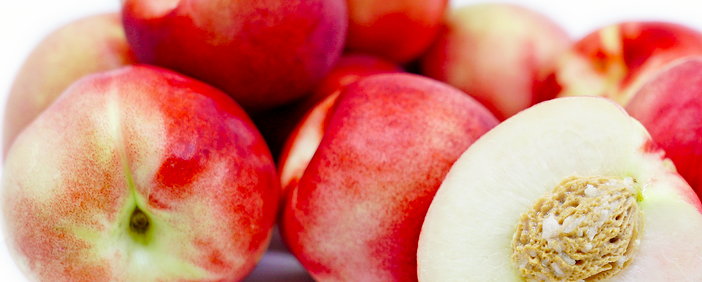
Nectarine is a peach with smooth skin, the core of which does not adhere to the flesh which weighs approximately 150g. She is originally from Asia and appeared in France in the 15th century. It is sweet and very refreshing, eaten raw as well in desserts as in salads for a sweet-savory mixture.
It is one of the most consumed fruits in France that can be found from June to August on market stalls and supermarkets.
Characteristics :
- Rich in vitamins and antioxidants;
- Average calorie intake;
- Source of fiber;
- Reduces the onset of cardiovascular disease;
- Protects from the effects of aging.
What is nectarine?
Food identity card
- Season: June to August;
- Family: Rosaceae;
- Origin: Asia
- Color: Orange, yellow, red
- Flavor: Sweet
Characteristics of nectarine
When harvested, nectarine has a smooth skin of red, orange or yellow color, just like its flesh.
Differences with nearby foods
Nectarine is very close to peach, of which it is a mutation. Their main difference is that the skin of nectarine is smooth unlike that of peach which is fluffy. Nectarine is also less fragile and supports handling and transport better than fishing.
Word from the nutritionist
To get the most benefits and vitamins from nectarine, eat it raw and preferably with your skin on. A nectarine corresponds to a portion of fruit.
Nutritional values
For 100g of raw nectarine:
| Nutrients | Quantities |
| Protein | 1.16 g |
| Fat | 0.31 g |
| Carbohydrates | 8.9g |
| Water | 87.6g |
| Fibers | 1.7g |
| Vitamin C | 5.4 mg |
| Provitamin A | 150 µg |
| Vitamin E | 0.77 mg |
| Calcium | 4.38 mg |
| Potassium | 201 mg |
| Selenium | 2.2 µg |
6 benefits of nectarine: why eat it?
- Nectarine has an average caloric intake which allows it to be consumed as part of a weight loss.
- It is a source of fiber to stimulate intestinal transit and fight against constipation. These fibers will also play a role on satiety and allow better appetite control.
- Nectarine is rich in vitamin C which will stimulate the immune system thus fighting against fatigue and the appearance of colds.
- Its richness in anthocyanins, powerful antioxidants, gives it protective effects against the effects of aging and plays a role in the prevention of certain cancers.
- Rich in water, nectarine is refreshing and helps cover water needs.
- Antioxidants will help fight against oxidation of LDL-cholesterol in the blood and reduce the risk of cardiovascular disease.
Choose the right nectarine
To choose a nectarine, the fruit must smell good and its flesh should be supple.
The different forms
There are different colors of nectarine: orange, red, yellow.
Keep well
If the nectarine is not ripe enough when you buy it, you can leave it at room temperature for one to two days. Do not put it in the refrigerator, it would make the flesh cottony.
Preparation of nectarine
How to cook it? How to match it?
Nectarine is delicious eaten plain, but it goes very well in both savory and sweet dishes.
Here are some examples:
- Pan-fried with butter and sugar;
- In a marmalade by passing them 3 to 4 minutes in the microwave;
- Poached in a syrup made from sugar or honey;
- Baked for 30 to 40 minutes;
- Raw mixed with raw salad or with mozzarella;
- In sorbet with verbena or mint;
- In fruit salad with red fruits;
- In clafouti.
History of nectarine
The origin of nectarine is unclear even if we are sure that it comes from a cross between a plum tree and a sinner. It may have been seen in Persia and we speak of it for the first time in France in the 16th century.
From the 1630s, several varieties were cultivated in England and the Spaniards took it with them to America in 1722.
There are now 1500 varieties around the world, a large part of which is grown in California.